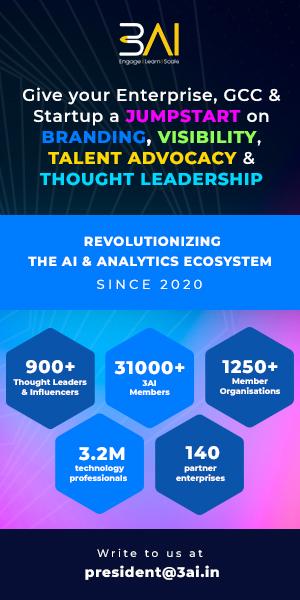Insights -as- a- service: The new AI model
3AI December 16, 2020

Most organizations realize the value in their own data and are increasingly faced with a deluge of new “big data” from sources. New technologies are available to help but internal teams and data warehouse platforms are already over-stretched.
At the same time, business users are demanding new data analysis to keep pace with, and get ahead of, competitors. But traditional development is often too slow and complex to address the immediate business needs.
Insight-as-a-service can become the next layer of the cloud stack (following Infrastructure-as-a-Service, Platform-as-a-Service and Software-as-a-Service). In addition to SaaS application vendors that can start offering such services, there exists an opportunity to create a new class of pure-play Insight-as-a-Service vendors. Regardless, vendors will need to start addressing the issues and many more that I can’t anticipate at present. But since surveyed customers are already starting to ask for such services, it is time to start creating them. It means that the time for Insight-as-a-Service has arrived.
Insight as a Service refers to action-oriented, analytic-driven solutions that operate on data generated by SaaS applications, proprietary corporate data, as well as syndicated and open source data and are delivered over the cloud. This definition is meant to differentiate Insight as a Service, which I associate with action, from Analytics as a Service, which I associate with data science, and Data as a Service which I associate with the cloud-based delivery of syndicated and open source data. For example, a cloud-based solution that analyzes data to create a model that predicts customer attrition and then uses it to score a company’s customer base in order to establish their propensity to churn is an Analytics as a Service solution. On the other hand, a cloud-based solution which, in addition to establishing each customer’s attrition score, automatically identifies the customers to focus on, recommends the attrition-prevention actions to apply on each target customer and determines the portion of the marketing budget that must be allocated to each set of related actions, is an Insight as a Service solution.
Companies that utilize analytic solutions (whether they are delivered over the cloud or not) use them to extract information from data. However, deriving insights from the information/analyses that result in actions is much harder and time-consuming. I had identified the difficulty in the inability of analytic solutions, or of data scientists, to first properly translate a business problem to a data analysis problem, and then to formulate (or re-translate) the analysis results into insights paired with associated actions in a way that business people will understand, and be able to execute. Even companies like IBM, muSigma, Opera Solutions which provide corporations with large scale outsourced analytic services they rarely provide insights and actions. There exist independent consultants who play this two-way analytics translator role very effectively but their extensive and continuous use by corporations is not feasible, mostly for financial reasons; they are too expensive and in too high demand. In past discussions with members of IBM’s 7000-strong analytics and optimization business unit I heard that those of their consultants who can provide such “two way analytic translation” and insight services are in the highest demand.
Several companies such as Acteea, 9Lenses, JBara, Totango, Startup Genome Compass, as well as a few that are still in stealth have developed such solutions, while companies like Host Analytics, 8thbridge and Dachis Group have created Insight as a Service offerings to complement their existing SaaS solutions.
Insight as a Service is a distinct layer of the cloud stack and is positioned above Software as a Service, i.e., the cloud’s application layer. The cloud provides insight-generation solutions with several distinct advantages:
- An efficient and cost-effective environment for collecting the SaaS application data but also for distributing and managing other appropriate data types.
- An environment enabling collaboration among teams of data scientists, analysts, business translators and domain experts in utilizing, refining and applying the insights and associated actions.
- Elastic computing and storage resources since insight-generation solutions are even more computationally and storage intensive than analytic solutions.
- A medium for rapid solution deployment and incremental improvement.
Insight as a Service solutions analyze data and recommend actions. The actions they recommend result in business process improvement, and business practice improvement. The Insight as a Service solutions of the companies I mentioned above do exactly that. To identify the right actions these solutions rely on:
- Data generated by SaaS applications, proprietary corporate data, as well as syndicated and open source data. For example, Host Analytics, which provides a SaaS application for corporate performance management, integrates customer’s budget data with data from ERP and CRM SaaS applications and open source industry-specific financial data for its Insight as a Service offering. 8thbridge combines open source data about Facebook engagement/use, YouTube use, Twitter use, Klout score, Tumblr use, Flickr use with its customers’ data to create the Social Commerce IQ index.
- Strong analytic functionality that includes both predictive modeling, and optimization components.
- Deep (including industry-specific) understanding of particular business processes and tasks. For example, Acteea’s solution has an elaborate representation of the keyword bidding process used by ecommerce retailers for search advertising.
- Business best practices. For example, JBara’s solution incorporates best practices for improving customer profitability or improving customer retention.
- Benchmarking practices through which a company’s performance can be compared to that of its peers and competitors, or to its past performance. For example, 9Lenses’ solution allows a company to benchmark its performance along several dimensions to that of its competitors. As Craig Schiff recently wrote, benchmarking will become an important component of corporate performance management.
Insight as a Service is starting to be recognized as a distinct and important layer of the cloud’s stack, as well as an important extension to analytic applications. As I had predicted, Insight as a Service solutions are being developed by new and exciting pureplay vendors, as well as by SaaS application vendors that view such solutions as a way to clearly differentiate their offerings. As the data generation pace along with the data diversity are increasing, and corporations begin to understand the importance of data-driven decision-making, Insight as a Service solutions will become as essential and as ubiquitous as SaaS applications have become.





